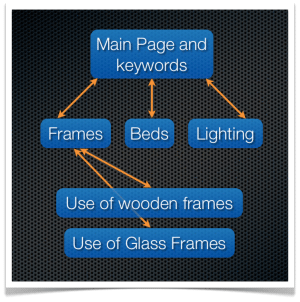When we start creating a website, it’s a common practice that we immediately start with the creation, template, plug-in selection etc..
What we almost always forget is to plan our site’s structure.

From the image above, we can see an ideal structure for a website. To explain myself better, we have to analyze some of Google’s rules and best practices.
 On every given page, we have links (internal or external) to other pages. The more links we have, the less value is attached to them.
On every given page, we have links (internal or external) to other pages. The more links we have, the less value is attached to them.
It’s been said, that when we have more than 50 links on a page, they are worth less than 1/50 of that page’s total value.
The ideal structure has to be:
Main Page > Categories > Articles.
If we have a portal with a lot of publishable material, then we could consider adding one Subcategory, but that’s it. Our visitors shouldn’t have to click too many times before getting to the article they’re actually interested in reading.
Let’s use an example to further our knowledge in categorization. Let’s say that we own a store that sells interior design supplies.
categorization. Let’s say that we own a store that sells interior design supplies.
Our website’s main page should welcome our visitors, feature what it is we have to offer and include further information about our products.
The main concept is that we want an article (“Use of wooden frames” for example) to “pass value” back to its category (“Frames”), so that then the category can then pass value back to the Main page. You may think that an article has little value to pass on to its category, but nowadays, with the use of social networks, we are able to submit any article we create to social bookmarking sites. This way, we receive a greater amount of links back to our original article, making it more powerful.
On the other hand, our main page is usually the most valuable and that’s why we have to think twice before overloading it with links. Our main page has to have as few links as possible so that all the categories (in our case Frames, Beds, Lighting, etc) will get most of our page’s value. Later on, this value will be passed on to the articles as well.
That’s the main reason why it’s so important to plan before creating a website. Knowing the categories and structure of our website before it’s created, will help make the final structure more efficient, not only for our visitors but also for the search engines!
Angel



Hi Angel,
i think you’ve done a fantastic job in discussing about planning out the navigational structure of a website. do you have an article on social bookmarking?
thanks.
Sorry for the late reply, nope, nothing for the moment but I’m planning a series because it’s THAT important ;)
Thank you for the comment and your good words,
Angel
annnnnnnd, I just read your post (http://www.moneytized.com/top-methods-link-building/), which referred here. And then I saw Glen’s comment above. Same question from me: have you created an article on social bookmarking?
Thanks for this. I’m a novice’s novice and the last article was pre-tty awesome and this one is great as well
Cheers
Aaron
Thank you for the good words Aaron! Truth be told, I’ve always avoided writing social bookmarking articles because the second I start thinking about one, I end up having written enough bullets for a whole series of more than 30 posts and in the end feel the need to finally do it…
After I finish with the book I’m writing now, I think social media and bookmarking comes up next ;)
If you need any specific points and guidelines before the posts, contact me through the contact form so we can IM ;)
Cheers!